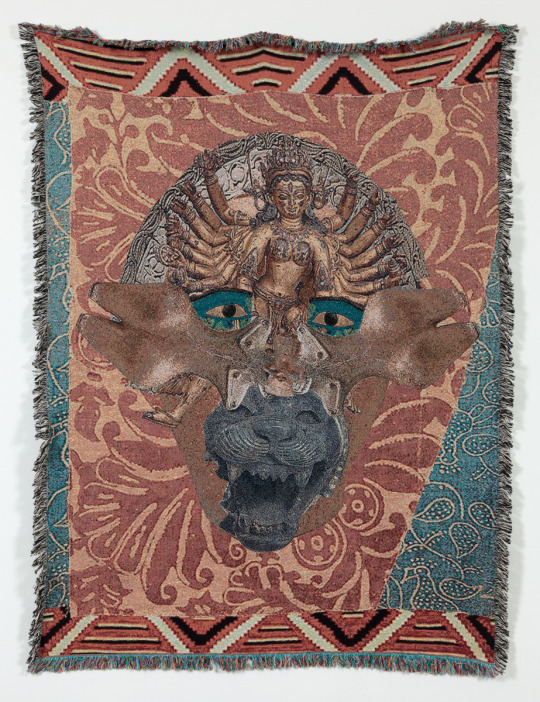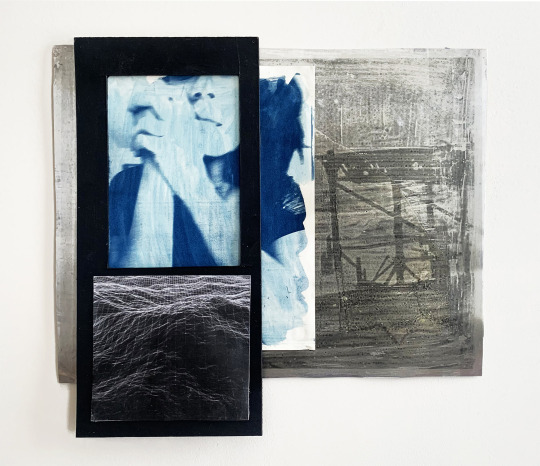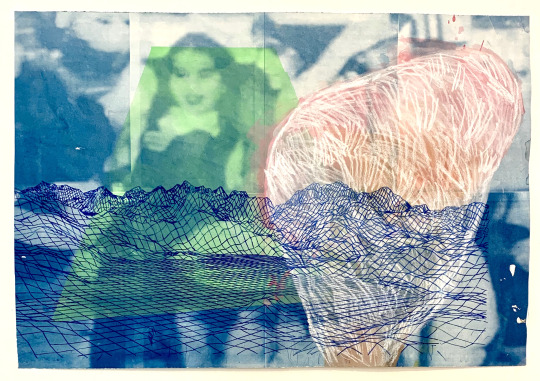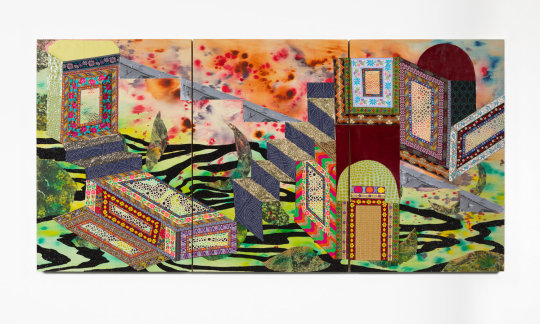#natalianakazawanazaninnoroozi
Text
2. Natalia Nakazawa & Nazanin Noroozi
Natalia Nakazawa and Nazanin Noroozi discuss their use of archives and photographs, creating hybrid narratives, cultural transmission, and the formation of personal and cultural memories.


Natalia Nakazawa, Obtrait I, Jacquard woven textile, 71 x 53 inches, 2015, Photo credit: Jeanette May
Natalia Nakazawa:
First off, Naz, how are you doing? There has been so much going on - it is far too easy to forget we have bodies. We have families, we have things we need to do, and we need to take care of ourselves. As they say, put the oxygen mask on first, and then help others. Can you maybe start by just telling us what your day looks like? What are you doing to take care of yourself?
Nazanin Noroozi:
I’m doing ok. I have to balance my day job and my studio time. My day job is working in high-end interior design firms in which our clients spend millions and millions of $$$ on luxury goods. It is very interesting to look at the wage gap especially considering the pandemic. When someone can spend 40k on a coffee table for their vacation house, and you hear all the issues with the stimulus checks etc, it makes you wonder about our value system and how our society functions.
As for self-care, I guess just like any other artist, I buy tons of art supplies that I may or may not need! I just bought a heavy-duty industrial paper cutter that can cut a really thick stack of paper! I needed it! I really don't have room for it, but I bought it! So that is my method of self-care! Treat myself to things that I like but may be problematic in the future. ;)
Natalia:
I recently re-watched Stephanie Syjuco’s Art21 feature online where she talks about having to actively decide to become a citizen of the US, despite having come to this country at the age of 3. One of the poignant points she brings up is how we are all reckoning right now with what it means to be “American”. She also brings up the iconic photo taken by Dorothea Lange of a large sign reading “I am an American” put up by a Japanese American in Oakland right after the declaration of internment - thinking about how citizenship can be given or taken away. This all feels very relevant right now. What do you think about these questions? How do you use archives and photos of our past to engage in these issues of belonging, citizenship, and the precarity of it all?
Nazanin:
What I try to do with archives is to question them as modes of cultural transmission and historical memory. I think many artists deal with archives in a more clinical and objective manner, whereas I like to add my own agency to these found photographs. When one looks at a family album or found footage, one is already looking at fragmented narratives. You never know a whole story when you look at your friend’s old family albums. I truly embrace this fragmented, broken narrative and try to make it my own. I also constantly move back and forth between still and moving images, printmaking and painting, experimental films and artist books. So there is this hybridity in the nature of found footage itself that I try to activate in my work. In these works handmade cinema is used as a medium to re-create an already broken narrative told by others, sometimes complete strangers to tell stories about trauma and displacement. That is what fascinates me about archives. The fact that you can recreate your story and make a new fictional alt-reality.

Nazanin Noroozi, Self Portrait
Natalia:
But who is to say these if fictional alt-realities are less important or less serious than purely “art historical” narratives? One of the things that I am exploring in my work is giving space for slippages in memory, rearranging of timelines to accommodate a lived experience. What happens when we look at collections - even museum collections - with the same warmth, tenderness, and care that we would an old friend? What possibilities are dislodged there? What benefit is there to towing the status quo - which is built on white supremacy, stolen artifacts, and other types of lying, exclusion and dubious authoritative storytelling? Also, there are so many family histories that often become reified - being told and retold with certainty over and over again. How do we claim agency from that oppressive knowledge? The things we tell ourselves about our families may not be “true” so what do we risk by revisiting our archives and re-telling those histories through our current eyes? When we re-examine the history - we may discover new ways of seeing and being with ourselves.
Nazanin:
I like to think of photographs as sites of refuge. When you look at a photograph of a kid’s birthday from many years ago, you know for fact that this joyous moment is long gone. These mundane moments that bring you “happiness” and security won't last. It’s like “all that is solid melts into air”. In a larger picture, isn't everything in life fragile and fleeting and there is absolutely no certainty in life? For example, look at how Covid has changed our “normal everyday” life. A simple birthday party for your kid was unimaginable for months. In “Purl” and “Elite 1984” I mix these mundane moments with images of flood, natural disasters and other forces of nature to talk about fragile states of being and ideas of home. I digitally and manually manipulate footages of a stormy Caspain Sea, Mount Damavand or a glacier melt to ask my questions about failure or resistance, you know? I let the images tell me the new narrative, both visually and thematically.
Something I find really interesting in your work is how you re-create these alt-realities by actively and physically engaging your audience into participating in your work, like your textile maps - called Our Stories of Migration? Do you have any fear that they may tell a story you don't like? Or take your work to a place that you didn't anticipate? How do you deal with an open-ended artwork that is finished but it needs an audience to be complete?

Natalia Nakazawa, Our Stories of Migration, Jaquard woven textiles, hand embroidery, shisha mirrors, beetle wings, beads, yarn, 36 x 16 feet, 2020, Photo credit: Vanessa Albury
Natalia:
I am always stunned by the generosity of the people I meet - those who dive in and share their own histories - and I think it points to a universal need of ours to share and connect. There is always potential to create intimacy - even within the walls of large institutions, such as schools or museums - when our own lives are placed at the center with care and concern. I’ve never heard a story that didn’t make me pause and grant me more space for contemplating the complexity of being a human on this planet. We have all kinds of mechanisms for memory - archives, written diaries, photos, paintings, objects - but at the end of the day they are nothing without our active participation. Quite literally they are meaningless unless they are being interacted with. That has been the entry point for me, as an artist and educator. How do we take all of these things that exist in the material world and make sense out of them? What does the process of “making sense” do to the way we live TODAY? Or, perhaps, how we envision the future? It is almost like a yoga practice, a stretching of the mind, a flexibility to think backwards and forwards - that lends us more space to consider the present.
Nazanin:
Yeah! I think you really are on point here! I think we really can't understand our existence without retelling the history and recreating new realities.

Nazanin Noroozi, The Rip Tide
Natalia:
Thank you, Nazanin! Anything coming up for you that you want to mention?
Nazanin:
Yes, I am actually doing a really amazing residency at Westbeth for a year. This is an incredible opportunity as I get to live in the Village for one year and have a live-work space in such an amazing place. Westbeth is home to many wonderful artists!

Natalia Nakazawa, History has failed us...but no matter, Jacquard textiles, laser cut Arches watercolor paper, vinyl, jewels, concentrated watercolor and acrylic on wood panel, 40 x 90 inches, 2019, Photo credit: Jeanette May

Natalia Nakazawa is a Queens-based interdisciplinary artist working across the mediums of painting, textiles, and social practice. Utilizing strategies drawn from a range of experiences in the fields of education, arts administration, and community activism, Natalia negotiates spaces between institutions and individuals, often inviting participation and collective imagining. Natalia received her MFA in studio practice from California College of the Arts, a MSEd from Queens College, and a BFA in painting from the Rhode Island School of Design. She has recently presented work at the Arlington Arts Center (Washington, DC), Transmitter Gallery (Brooklyn, NY), Wassaic Project (Wassaic, NY), Museum of Arts and Design (New York, NY), and The Metropolitan Museum of Art (New York, NY). Natalia was an artist in residence at MASS MoCA, SPACE on Ryder Farm, The Children’s Museum of Manhattan, Wassaic Project, and Triangle Arts.
www.natalianakazawa.com
@nakazawastudio
Nazanin Noroozi is a multimedia artist incorporating moving images, printmaking and alternative photography processes to reflect on notions of collective memory, displacement and fragility. Noroozi’s work has been widely exhibited in both Iran and the United States, including the Immigrant Artist Biennial, Noyes Museum of Art, NY Live Arts, Prizm Art Fair, and Columbia University. She is the recipient of awards and fellowships from the Artistic Freedom Initiative, Elizabeth Foundation for the Arts, NYFA IAP 2018, Mass MoCA Residency, North Adams, MA and Saltonstall Foundation for the Arts Residency, NY. She is an editor at large of Kaarnamaa, a Journal of Art History and Criticism. Noroozi completed her MFA in painting and drawing from Pratt Institute. Her works have been featured in various publications and media including BBC News Persian, Elephant Magazine, Financial Times, and Brooklyn Rail.
www.nazaninnoroozi.net
@nazaninnoroozi
3 notes
·
View notes